-
Posts
32 -
Joined
-
Last visited
Content Type
Profiles
Forums
Articles
Gallery
Downloads
Events
Posts posted by Shalev Zohar
-
-
One point that didn't come up here is your anvil; If you have a light/unfastened anvil/aso, its give might steal a major slice of your strike power. I've had this happen to me with my first 7kg aso, things weren't moving as fast as they should, especially in upsetting, because the whole thing was moved by my swings. My heavier new aso's have less of this problem. I don't know what you hammer on but if it's light at least give it a proper stiff stand. Might improve your speed a lot
-
On 05/04/2018 at 12:06 AM, ThomasPowers said:
Design: learn what makes a good sword vs what makes a bad sword or even just a sharpened hunk of metal. (Hint: weight, harmonics, cop, non-slick grips...)
Harmonics are my main concern; I'm sure they won't be as good as they can, and I find it hard looking for tips on them. I'll generally try my best with tapers and weight distribution and hope the harmonics will come with it.
Grips are my stronger side, wire wrap might be harder than it seems.
In regards to the design I'm thinking about switching to a sidesword, might be easier.
On 05/04/2018 at 12:06 AM, ThomasPowers said:Strongly suggest you do *NOT* use a fatigued leafspring as starter stock; buy new straight stock from a spring repair/replace place!)
Not fatigued, it was kept as replacement and didn't see much action, only collected some rust. I'll still buy new stock if I find good ones, but overboard is a lot of shipping costs and over here it's nonexistant/comes in tonnes.
On 05/04/2018 at 12:06 AM, ThomasPowers said:A poorly heat treated blade can kill a friendship in a very literal way.
I'll probably search for someone with an electric kiln big enough because I doubt my abillity to get even, good heat. I probably have the connections needed for this and will beat this obstacle once I'm there. A good kiln solves all the problems. Once I'm done I'll try a safe flex test to make sure it won't break when it's not in a controlled environment, and of course never fling the thing violently at hard objects, especially when said friends are within launch range.
-
On 26.3.2018 at 10:48 PM, Frosty said:
We have a 15 yr old in the club who makes meetings occasionally and has been using open forge time to beat on a piece of spring steel. Been doing it for about a year now to no avail. The worst part of spending all that time is he isn't doing any basics so he isn't learning a thing. Last summer we had a forge in, camp out, at the Matanuska River camp ground with 3 stations. He couldn't draw a square taper, let alone head a nail or turn a scroll, couldn't make a tent peg. The only thing he's taught himself in the last year or so is to flail away on a piece of old leaf spring. At meetings he does the same thing with a power hammer. It's not MY idea of makin bacon.
It's sad to see so much time and talent wasted on a fool's project. But so goes the teen years. Remember knowing so much more than those old farts? I do, I'd REALLY be embarrassed if there weren't fresh generations doing the same thing today.
We held our March meeting last Saturday and I couldn't stand it any longer and had to tell a new guy to take off the glove on his hammer hand, then spent an hour or so couching him. I have no idea what he wanted to make other than a . . . Wait for it . . . knife of some sort. He was forging on a CV shaft with no idea what it's made of, let alone how he was going to get a 1" Dia. round shaft a good 6" long worked down. He was just beating on it and had it sort of squared off.
I got him to realize how more accurate and stronger he was without the glove. Then learned how much more the steel spoke to him without the one on his tong hand. He learned about cooling the reins off on his own.
 Nice kid, listened and tried to apply what I told him. I don't know if he'll just buy some 3/8" sq. or 1/2" rd. mild though. I think I'll just bring some to the next meeting.
Nice kid, listened and tried to apply what I told him. I don't know if he'll just buy some 3/8" sq. or 1/2" rd. mild though. I think I'll just bring some to the next meeting.
Have at it Shalev, it's your time, your fire, your arm. Why should you be any different that we were when we were know it all teenagers? Well . . . I was going to build a hydrofoil submarine but I grew up in a machine shop and had an anvil and fire since I was maybe 9. No, not a London pattern it was just a heavy piece of bar Dad left over fro building a spinning lathe and my fire was wood with a hair drier for air. It was the hydrofoil submarine that was THE project that was going to make my name,Yes siree! My sister still has the notebooks and drawings, the folks never threw away anything.
Frosty The Lucky.
I'm no master, all forging projects I do are first times. I mess up a lot and take much longer due to lack of experience. I cracked knives in water quenching and burnt them in the forge, I dropped hot metal, made my fair share of rebar things that shouldn't be rebar and got burnt and cut.
I'm no noob either. I've put in the years and experiments. I used what I have and forged a wide array of tools and weapons. I love forging and I love learning. I'll never make the same thing twice. It's a tough project but I came here to learn, I've already got much needed advice and changed my plans majorly.I've been forging a long time before thinking of a sword, I'm in no way fully prepared to it but I think my chances are okay.
This is not a whim project, I do a lot of preperations, just made a better forge and my first tongs, planning on making a dagger as was recommended here to practice bevels. The sword will take a lot of time until created. It might fail, and if I succeed it won't be perfect, and I'll be slower than a dead turtle on land. But I don't want a sword, I want to make a sword. If I fail, so what?
Bottom line: please don't discourage my project. I may not be fully qualified but it's something I want to try before I lose the opportunity. There's no harm in me failing- not to me nor to you.
All I need is advice; If you threw me into a blacksmith's shop this moment with only what I know, I wouldn't be able to make it from beginning to the end of this project. I'm open to anything, the more I know the bigger the chances I succeed.
43 minutes ago, ThomasPowers said:I think I'll wait for the season "Old Age and Treachery"...
I do like teaching wearing my "Hold the cold end and hit the hot end---get it right next time!" Tshirt I bought from Glenn (From a saying of Jim Green of Columbus OH).
I just did two identical pieces for tongs, one I flipped to work on the back, then laid it on the ground. A bit ashamed to admit but I forgot I flipped the thing, and came to pick it up with the wrong side. Glad I wore a glove, my hand is okay, the glove has a hole. To my defense I wasn't injured in blacksmithing a whole year, quite a feat for me.
-
On 26.3.2018 at 6:58 PM, Latticino said:
Last weekend I watched a beginner ignore my recommendations and attempt to forge an 18" long froe out of an old truck spring. He spent 6 hrs in a gas forge working on upsetting it to get it down to the width he wanted and still hadn't started on making real bevels (admittedly he lost about 2 hrs of work when he foolishly quenched his first billet in water to cool it and then didn't immediately start over. Found out about high carbon steel cracking pretty quickly after that).
5160 is tough stuff to move by hand without a stricker, especially in 1/4"+ thickness, and as a beginner he wasn't working very efficiently. You likely won't be either. Finally mig welded on a handle so he didn't keep losing the billet in his flat tongs, but that is still much easier than trying to forge out a sword with a non-fishmouthed tip, a tapered tang, good even bevels on both sides and a correct distal taper overall.
Not to mention that the forging part of swordmaking is arguably the easiest part. The grinding, filing and heat treatment are equally challenging, and a lot less fun. However those are the operations that make the difference between a usable sword and a wall hanger.
I have no idea why you think you need your sword to be more than 1/4" thick (do you have any idea what the final weight will be? A single hand sword shouldn't weigh more than 3#, so do the math and figure the average thickness needed).
I dropped the need to upset, no way it'll work. 5mm is thick enough and I have a longer piece I can use. I wanted 7mm in the base because it's normal in both swords and rapiers, I wanted extra material for the grinding and I wanted extra rigidity to both keep it from bending or breaking, in the quench or in use. Of course I'll do a distal taper.
Trust me with not quenching the thing in water, although can't say I didn't tortured knives like that in the past...
Why is fishmouth easier? I've never heard such thing.
I'll forge the distal taper, tang and tip, maybe the fuller too, but I'll probably grind the bevels. I'm more trusty with my skills in grinding and it's harder to make critical mistakes fast that way.
It'll have a good distal taper, be short, and have a less complicated hilt; It won't weigh more than 3 pounds even with the thick base. Worst case scenario: It's too heavy and I grind a bit more.
-
On 26.3.2018 at 5:36 PM, arftist said:
Firstly try a simple upsett in mild steel. When you realize how extremely difficult it is you will throw away your scrap leaf springs right away and buy stock the correct thickness.
Just did in some 2.5/1 ratio while making tongs, it shroomed a little and not much trouble beyond that except for the usual taking lots of time. You're correct, upsetting 8/1 ratio (what I hoped for) would be impossible; With a dedicated tool maybe, but still a worthless struggle. 5mm is still enough for the sword, yet I am looking for alternatives
On 26.3.2018 at 5:36 PM, arftist said:NEVER USE USED LEAF SPRING FOR ANYTHING OTHER THAN WEAR PLATES
WHY?
On 26.3.2018 at 5:36 PM, arftist said:Don't care how much time you have, not enough time in the world to die young from stubbornness.
You are equating using a leaf spring that survived a flex test to make a sword that'll be responsibly handled, to killing myself. I've searched on other sites and it seems like many people did it and almost nobody ran into problems except the need to properly anneal it so it won't bend back.
On 26.3.2018 at 5:36 PM, arftist said:The main give away is your concept that the hard part is keeping it straight. That is the easy part. Straightening is a skill you clearly don't have yet it is the most basic of skills.
I didn't say that. At some point the metal would rather bend or shroom instead of upset and then the material will hardly upset no matter how many times I try. I fixed many bends, it's one of the easy things in forging. A few days ago I even let my cousin who never forged before do some straightening and he did just fine. It's not the bending that is the problem, it's the bending instead of upsetting.
On 26.3.2018 at 5:36 PM, arftist said:When our boss (Glen) says buy new, just buy new or don't do the project.
I came here for advice, not orders.
On 26.3.2018 at 5:36 PM, arftist said:Dude, you know so little that it is ridiculous to attempt a sword.
Watch me.
-
On 25.3.2018 at 10:48 PM, ThomasPowers said:
I'm using google Chrome on Kubuntu Plasma and just ran the search on those terms I mentioned from the splash page.
I don't know this system, I believe you and next time I will search more. It's weird but Google works in mysterious ways.
-
On 3/25/2018 at 1:29 PM, JHCC said:
If the microfracture is entirely within the blade, there’s no way to see it from the outside without specialized equipment. In such a case, the only way you’ll know it’s there is when it breaks.
In other words, you won’t know if you’ve made a blade or a bomb.
Are you willing to accept the moral, legal, and financial consequences for what happens when a sword blade shatters? Are you willing to live with knowing that you’ve caused injury or death that could have been avoided by purchasing a new piece of steel?
Save yourself the headache. Buy a piece of new 5160 that’s thick enough that you don’t have to worry about upsetting it edgewise.
I'm not at my home right now but when I come back I'll be sure to search for some new metal first thing. If I find a good buy I'll take that, but shipping is always a problem and no price will be better than none. I stood on the leaf and curved it a few nice degrees, it was perfectly springy and shown no issues. even if I'll choose to work with the leaf, I'll test quench a piece first so the sword won't be too brittle, search for cracks, hit some things when it's not sharp and I'm fully protected and do a controlled bend test to see if it brakes. If it doesn't fail it shouldn't fail later, unless I put it under circumstances that would break normal swords. I'm not going to abuse the thing and obviously not going to do it while people are anywhere near. It's a sword, I'll handle it with caution. There's always the option of trying to pattern weld as well, where even normal cracks should do no harm (please do tell me if I'm wrong), that'll delay the project until I'm familiar with pattern welding.
Keep in mind, I'll probably end up with new metal, the spring poses lots if issues, and if I pick it I'll put it under less use to keep it safe.
-
6 hours ago, Glenn said:
Show your advancements by continuing to post, with photos.
Leaf springs
The cost of new known metal is reasonable now days.
As to how far CAN metal be upset? How much time and equipment do you have?
That'll mean multiple topics for such a long project, isn't there a way to keep it to one place?
My spring was kept as a replacement one, but I don't know how much use it saw before that. Can you detect the microfractures after polishing?
I have enough spare to make a test piece for the heat treating. I have the time and spare metal to risk a break, but I'll check into new steel, if it's not too much cost for both the metal and shipping I'll consider it.
My options are: Make a tool for upsetting and procceed as planned/ try working with what I have and maybe still make it/ use a longer piece of leaf I have/ fold and make pattern welded steel, using hand hammers (eek)/ buy new steel.
As for the upsetting I'll repeat a little: I only have hand hammers, some heavy. I've got lots of time, not too much skill, and I can weld a dedicated tool to keep it straight.
-
4 hours ago, ThomasPowers said:
"In industrial practice the maximum aspect ratio that can be easily worked on edge or upset is 3:1. This phenomena is independent of hammer or press size"
Doing a web search on: max upsetting ratio iforgeiron.com I found the above and multiple posts discussing it.
Thank you, and sorry for asking something that has already been answered. I tried doing many searches like this but it seems like searching inside the site was a bad idea and outside probably didn't use the correct keywords. I tried doing your search but had to modify it to make it work.
This is unfortunate for me because I'll have to find workarounds, but I do have some.
now that the topic is not as relevant is it commonplace to take it down?
-
Hey, me again!
Not much progress with the sword, as to be expected. I'm still setting up the new place, I will hopefully make a killer forge in a week, and then some tools to pile up.
This is the problem: I want to make a sword with a base thickness of 5-7mm, base width of 2.5-3 centimeters and length of at least one meter, and a lot of extra material to grind because I don't trust myself enough with making clean forging work in there. I've got a 5mm thick 6cm wide 70cm long piece of spring steel. to get both higher thickness, length and take advantage of the axcess width I want to upset as much of it as I can.
My question is: What is the width to thickness ratio at which the leaf will no longer upset but just mushroom or crumble?
or more simple to me: the maximum width at which you can still upset a 5mm thick bar?
I'm no expert in this and I don't want to fight metal for too many hours, so this needs to be a reasonable width as well, I will square the bar beforehand with a disc, but I'll also cut the final working bar out then and for that I need the width. I changed my mind and the bar will not be sword shaped as in the picture but just rectangle.
I'd also welcome some general upsetting tips
And a quick question: How'd you recommend for me to show the advancements in the sword project here?
-
25 minutes ago, Steve Sells said:
you say you are ready to make swords but dont know enough to make the tools you need to make them ?
Can't make a belt grinder, it will be practically harder than a sword for me. I'm also less interested in messing with electronics and such. Building a gas forge that will let me get even heat will be less practical than finding one that already exists. I forge on my free time and give away forged stuff to my friends because I just enjoy forging. My free time is very limited and I won't use it for stuff I don't enjoy. I will however try making simpler tools that require only forging, maybe some tongs and hammers. Don't know how practical it'll be because the shop I'm intending to join will probably have both them and the heavy tools.
9 minutes ago, Daswulf said:Well now you know the dangers with getting springs off of a strut assembly.

The more mistakes I make the more dangers-to-avoid I can put into my glossary :^)
-
9 minutes ago, Daswulf said:
Patience is important when using tools of all kinds.
I'll be happy if the sword is made in less than a year, I take that as a long term project (like all my projects. my first knife waited a year until I put a handle on it) , I'm in no rush.
Although I like to take shoutcuts I won't risk my health for a sword, at least when I know there is a risk...
-
On 3/13/2018 at 9:56 PM, JHCC said:
I think there are some threads in the Heat Treatment section of the forum about using kilns. I’m just guessing, here, but unless it’s suspended vertically or lying perfectly flat, there may be an increased risk of warping. Good temperature control, though.
Rapiers tend to go bananas (literally) by the slightest mistake before the heat treat, that's why mine will be extra thick and short.
The main problem probably is that a Rapier won't fit in your average kiln... That is unless you bend it in two while in the kiln and straighten it back right before the quench! (A terrible idea for many reasons)
SWORDS DO NOT MAGICALLY TURN INTO FRUIT
-
On 14.3.2018 at 4:04 AM, genesaika said:
Don't, however, assume that you need those tools in order to work on anything.
I never assumed, I need to use these tools to cover my lack of experience and free time, I want to try larger things and don't have the patience to wait until I can do it with what little tools I have now
-
19 minutes ago, Daswulf said:
You need to move the sword back and fourth in the coals to get an even heat. it's just like fire management but metal management. You Do on the other hand need a container that you can quench the whole blade and then some way to temper it.
I can't believe I actually forgot. With my kind of forge it's just mechanicly inpossible, so I forgot it was a possibility, but I can build a forge that does the job in half a day. Still, now that I think of it won't it be better just going to my former art teacher and ask to use her kiln? I'm not sure of my abillity to get an even heat and keep a rapier straight.
-
3 minutes ago, JHCC said:
“Sword-Shaped Object” And “Knife-Shaped Object”.
Ah, the classics.
-
4 minutes ago, Daswulf said:
I have made some fancy fully polished sso's and kso's before. No worries. I still have intentions of eventually making a real sword someday. Have done a knife and started others after some years of forging experience. Upsetting depends on your ability. Practice! I have done a bit of upsetting material lately and actually like it. 5mm will take some skill to keep it straight and even. seems to me the larger the stock the easier to keep it even. 5mm by what? if its square or round it will be difficult. if it's rectangular, I'm not sure as I havn't tried much like that yet. All I can say it a few taps, straighten/flatten, few taps more repeat. And keep it up to a good movable heat for the steel used.
I've got no clue what sso's and kso's are...
I'll be using the leaf spring, will cut it into thinner square stock before forging, but I want to cut the least I can and upset the rest of the width because I need to icrease the thickness and length, the spring really is too short. So I'll try the maximum width that 5mm can bear, but I was aiming for around 4 centimeters of width to reduce to 3.
I'm notorious for forging metal while too cold, I can live with small parallel cracks in my thick knife but I won't be making that mistake with a sword, I will take your advice.
-
9 hours ago, ThomasPowers said:
I would strongly suggest not working on a sword till you get a dedicated shop with *ROOM*! Easy to catch/bump/drop a long work piece in a constricted space and the damage done may not jut be to the workpiece, or the shop---it can be *you* that gets the burn/cut/burn-cut. Also tooling up will make making swords a lot faster and less frustrating.
But yes you can make a forge with just a simple forge, anvil, and a number of files and MASSIVE amounts of time. Don't forget the Harmonics of the blade and the role of Distal Taper. (also in rapiers: give some thought to the ability to forge weld baskets up out of a number of rods.)
I have room, an electrician's workshop(grandpa), so I'm just lacking tools. I'm currently looking for blacksmiths who I can bribe to give me space in their workshop, but that I'll need just for the quench and grind, I can manage the rest in grandpa's garage.
I already got burned, cut, but still not burn-cut, intimidated, but hopeful.
I've deciced on the measurements for the distal tapor already, though it might be a tad front heavy, it'll be more cut oriented.
How can you quench with a simple forge? the thing is a meter long and needs to be entirely, uniformly above critical temperature. My simple forge annihilates one part of a knife while the opposite one remains cold.
I don't know enough about harmonics, I'll try learning of it and will do my best with the sword, mostly being hopeful, forge welding a complicated hilt is beyond me, even welding one probably is, I found a work-around which is within my skill set- just a dome (boss?) and a simpler rod arrange.
(the blade will be a little longer, this is the rough sketch and I didn't really notice the proportios were off.)
-
I've read the rules, didn't know what I used counts. Won't use it anymore although I am struggling.
Thanks, I'm coming from an artistic background and I've been drawing weapons long before I started making them.
I finish the blades on whetstone so it comes out in a weird messy pseudo mirror polish, I really don't have any other means, not even buffing compound. I'm not intending to use sandpaper, life's too short for that. It's also too short for filing an entire sword, sorry... But I'll find a solution.
About my ability to make a sword- don't tell frosty but I'm not sure either, yet I'm willing to try either way, I already created one faliure of a sword, nothing can stop me from creating two.
I have a very specific question- if the thickness is 5mm - what will be the maximum width of the bar that will still let me upset without just crumbling, also some other questions, no need to answer me here, I'll be posting the topic soon.
-
10 hours ago, Smoggy said:
.
(I hope I'm quoting okay^)
I'm not here to fight either, but I can't have productive discussion when you presume I don't know anything about forging and get this "Don't feel lonely though, you aren't the first teenager to want to jump into blacksmithing by making swords. We hear it all the time" disregard. I get that you are probably approached everyday by people who didn't use a screwdriver their entire life and want to make a greatsword/katana from rebar they found in their backyard, but please be patient with me, I know what I'm doing (hopefully)
I know my limits, and I know the proccess of making a sword. My plan is simple and up to my limits- a short not-sure-you'll-agree-it's-a-Rapier-at-all-sword, wide and with only a true edge, which will be made with 60% stock removal. I've already drawn it and done most of the planning and dimentions (I actually came here to ask about upsetting for the sword because I want to get it to 7mm in the base instead of the 5 of the leaf spring but the width-thickness ratio is borderline too much for that not to just fold/ shroom).
.thumb.jpg.cc660281caee0b3a927ccafdaa36b0af.jpg)
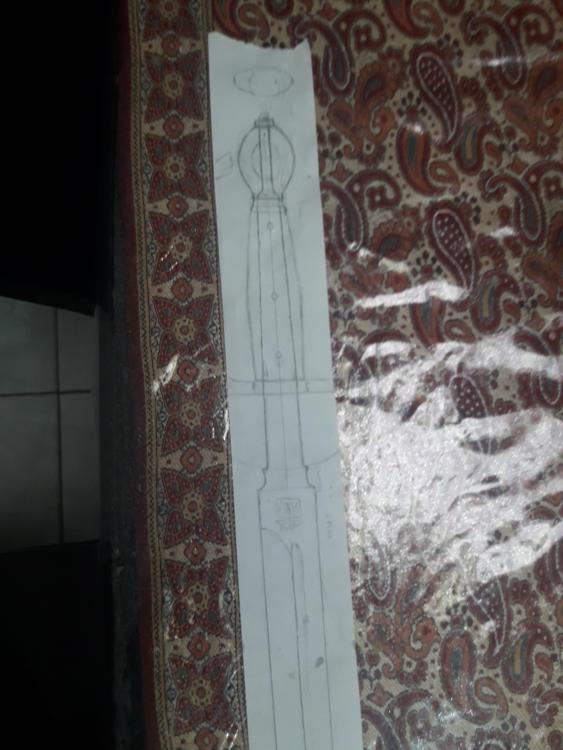
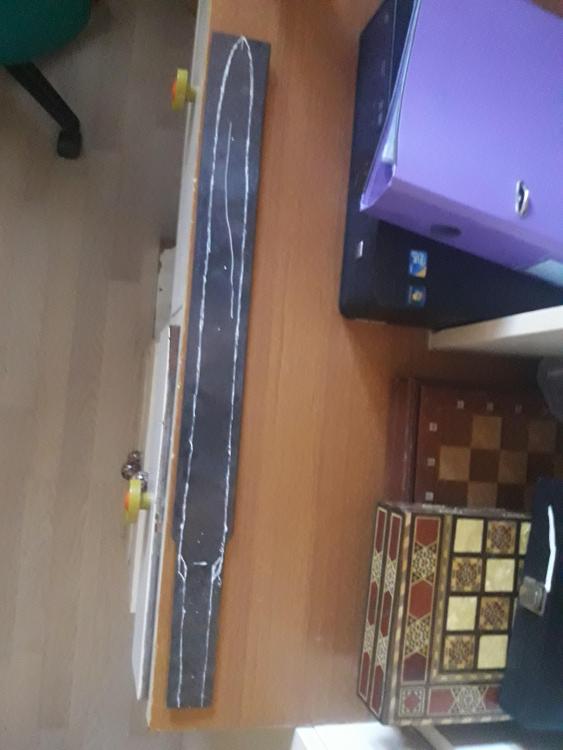
I've made stuff before, I already talked about it so just have the images (I'm a very artistic person who shouldn't use fake fur). You can judge however you like based on that, the smaller knife was made from THAT spring...
I could use more practice before making a sword, and will probably get it before I get access to the tools. Engineering and blacksmithing have major differences, if you haven't ever laid a hammer on hot steel then a sword really is not gonna come easy, but not attempting isn't the way. The first year and a half of my forging was soft ugly props for costumes, I came here by doing things out of my skillset until I got the skillset. I made a xxxx "Katana" two years ago- soft crude fat construction steel atrocity with no real handle. Did it kill me? No. Go make a sword, mess it up, who cares. You'll live on, and then you'll make better swords.
My first forge was mud and bike pump, my current one is grill and vaccuum cleaner, but I need to quench the sword somehow when it's all hot, and generally have a forge that doesn't melt my steel in its whims (it ate an entire knife). And that grinder is better off in the trash, it's already almost done for (but xxxx, it did cost only 20$).
-
3 hours ago, JHCC said:
Don't knock messing around with tools! For the hobbyist, that's half (or more) of the fun!
I think Shalev Zolhar meant "a rapier, no less", but I could be wrong.
For sure, and also I spent in total probably less than 400 bucks for three years of smithing, which is a great plus. But I want to try harder things which are beyond cheap tools and I have many other hobbies and forging just can't steal all my budget and time, so I'll be looking for other people's workshops instead of making my own.
You are correct, I'm no native talker by any standard and most of my English comes fron Youtube and forums, brace up for many other slips.
-
6 hours ago, Frosty said:
then you don't know enough about them or the craft to be thinking about blades let alone swords.
you aren't the first teenager to want to jump into blacksmithing by making swords. We hear it all the time.
Why so hostile?
I don't have a space where I can both keep the tools and work, I spend hours moving them, modifying them, buying them, working in different locations and just wasting time because the tools are too slow/not made for the task. I've made multiple knives, some fully forged, all of them hardened, some axes, a hammer, a shield boss, an arrow head, and a bunch of other stuff. I've been forging from time to time for more than three years. I want to make a sword and I probably can (with the right tools).
-
11 hours ago, JHCC said:
What do you need the horn for?
All the hilt, generally more control in bending metal, I have many other projects that include bending bars. I could use tubes in a vice to round around but a horn will be much more comfortable, and as I said an anvil is not my greatest concern.
-
20 hours ago, ThomasPowers said:
You have no anvil? I am *shocked*; I thought israel had forklifts, bulldozers, tanks, and a lot of other heavy items made of pieces that would make perfectly good anvils.
Please remember to not confuse not having a london pattern anvil with not having an anvil of a type that has been around for several thousand years longer than the London pattern ones have been.
I don't own any tank.
Seriously though, I have a makeshift anvil, but it's not hardened and I need a horn for what I'm planning to do (a first sword, and a Rapier nonetheless). I know I don't need any professional tools to make great things but I need to step up my game because I spend 90% of the time just messing with the tools.
The anvil is actually not a big concern of mine at all, I first need something better than a 180w bench grinder and a long forge, I just tried to roughly show what I've got.


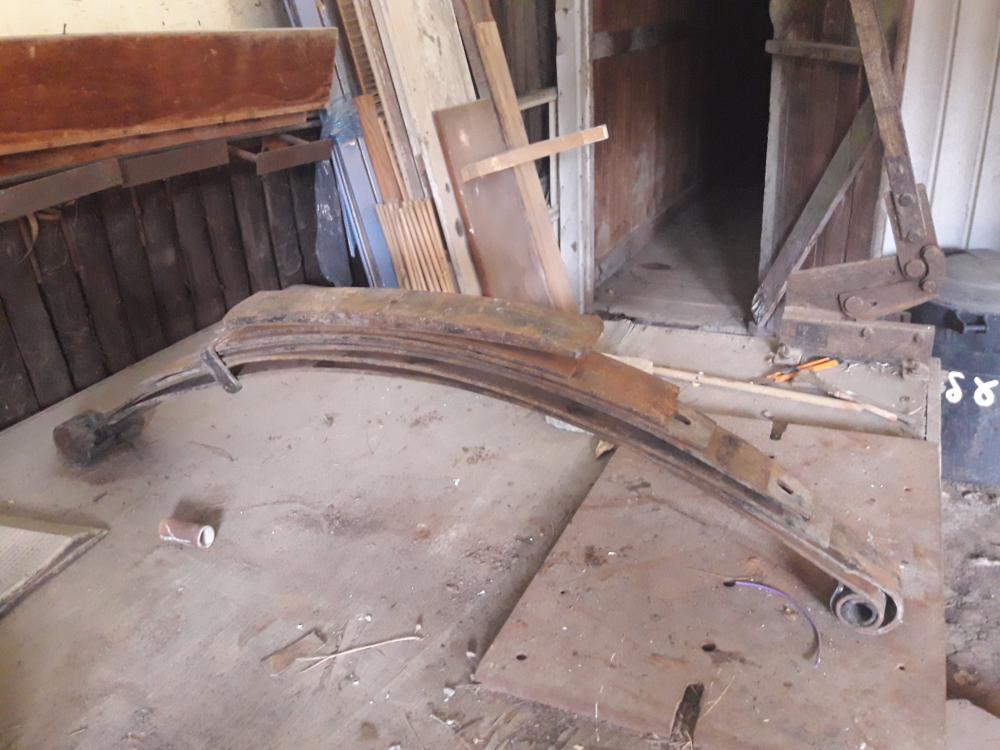
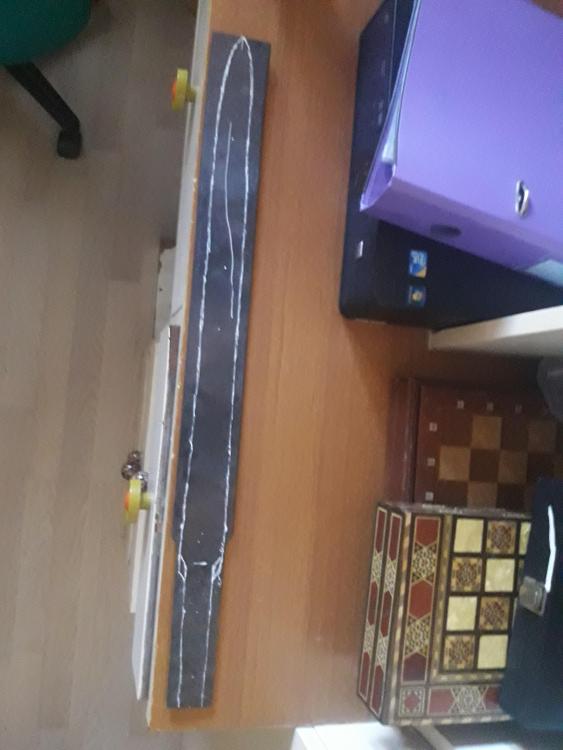
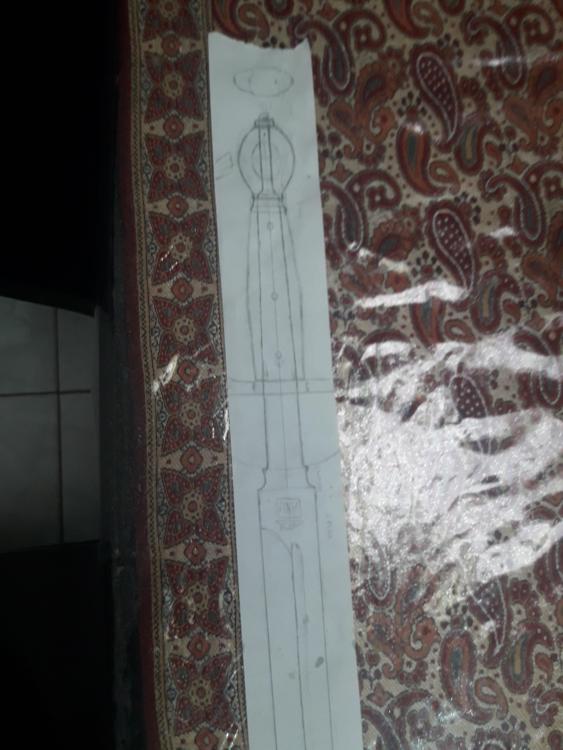
.thumb.jpg.b13aa09f92b7a095e6be89a7683df969.jpg)
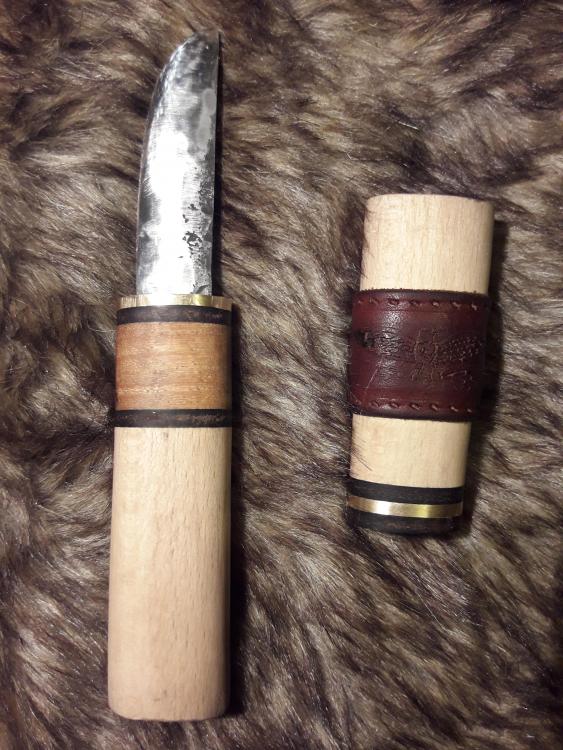
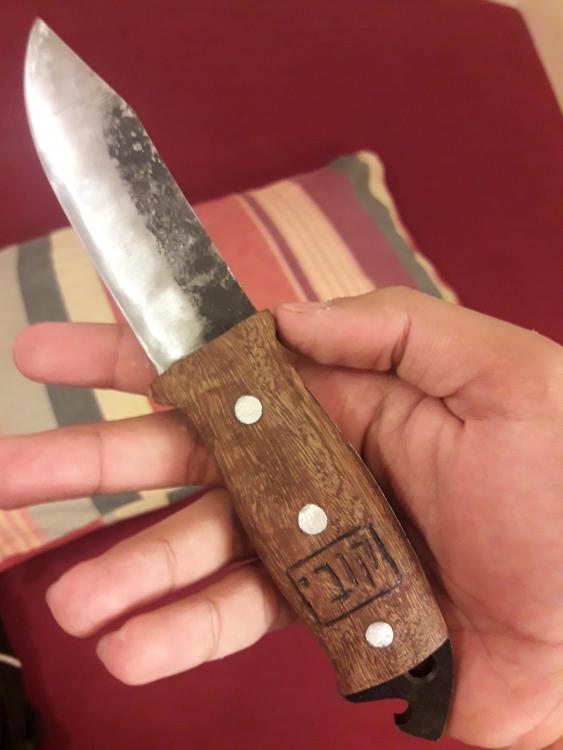
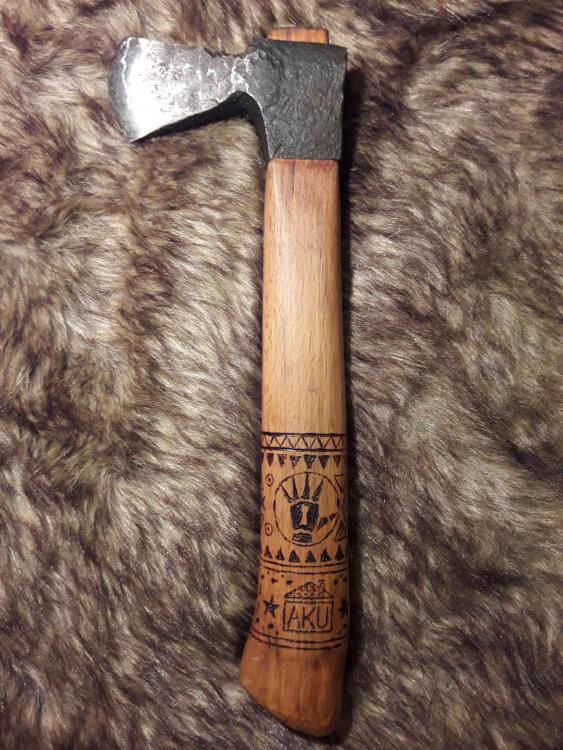
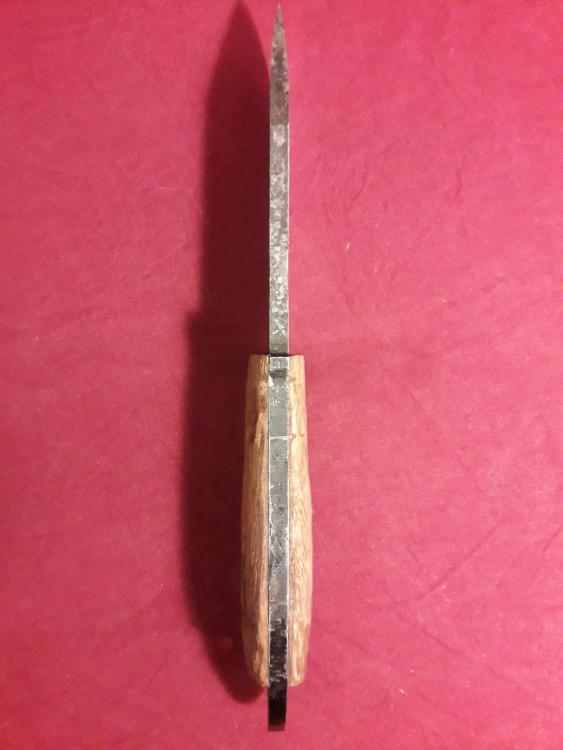
Upsetting width to thickness limits
in Problem Solving
Posted
I think I'll do good by messing with the sword tapor and pommel weight & length, I'm patient enough to not get it right first or second time.
I don't know what you consider hard but this sounds pretty hard. The best I can do is hand wrap it with some tention, I don't have any dedicated tools. if it wouldn't do I can stick to wood. I'm not fond of all metal gray rapiers, I think of casting some brass parts and brass covering some metal parts to get some more color. If anything, the sword will at least look good. Can you combine bronze or brass into your wires and make it look good?